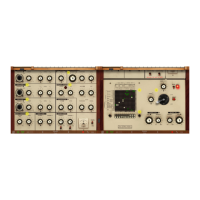Triplets : 1/1T, 1/2T, 1/4T, 1/8T, 1/16T, 1/32T, 1/64T
Dotted : 1/1D, 1/2D, 1/4D, 1/8D, 1/16D, 1/32D, 1/64D
Where ‘D’ is a dotted note and ’T’ is triplet.
With 1/4 (Default), the Sequencer will fire a ‘step’ every BPM according to
'Local Tempo' or 'MIDI Clock’ BPM.
• 1/4 - each step is a quarter note (or BPM),
• 1/4D - each step is a dotted quarter note (or 1.5 x BPM),
• 1/4T - each step is a triplet quarter note (or 0.5 / 3) etc.
Feedback
The SCOPE jack-socket is connected to Column A in the Patchboard (Matrix)
and therefore sees any output connected to the METER.!In conjunction with
the Control Output sockets there are three possible ways of gaining access to
the Matrix Board. !Although this socket is marked SCOPE (for Oscilloscope),
it can be used for a variety of purposes, including feeding back a signal into
the Studio via one of the Input Amplifiers (see section V in the official VCS3
Putney User Manual).! Naturally you can rescale feedback signals with knobs
(exponential knobs).
Oscilloscope/Spectral
Oscilloscope can manage time scale for zooming and amplitude input gain,
you can read either DC and AC signals.
In Spectral mode, the time scale and amplitude are used as exponent to
logarithmically display the frequency and amplitude. The frequency analysis
FFT (i.e. Fast Fourier Transform) is 4096 samples.
Mic/Samplers
You can feed iVCS3 with two samplers and/or mixed signal from
microphone /line or Audiobus/Inter-App Audio when connected. See the
original VCS3 manual for more details.
You can touch and drag the sampler’s waveform to scrub the audio file. The
speed of the scrubbing is relative to the position of the finger inside the
waveform: higher positions produce faster scrubbing
# Tap the symbol to set the loop points. When in "loop edit mode" you can:

